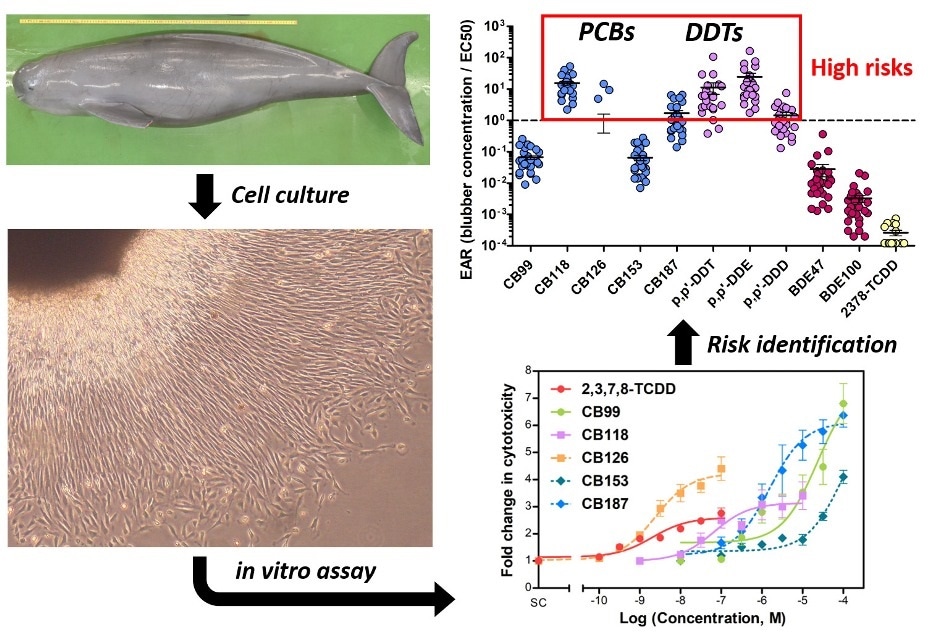A new study has revealed that environmental pollutants pose toxicological risks to finless porpoises (Neophocaena asiaeorientalis). The study was recently published in the Environmental Science & Technology journal.

Cell death and risk assessment of finless porpoise fibroblasts by exposure to environmental pollutants. Image Credit: Reprinted with permission from Environmental Science & Technology. © 2020 American Chemical Society.
Artificial chemicals produced for human activities endanger the health of marine mammals. Researchers have known for a long time that such chemicals, like persistent organic pollutants (POPs), build up at high levels in several dolphin species.
In finless porpoises living in the Seto Inland Sea, the POP levels are greater when compared to those of other cetacean species spread in the waters close to Japan, and the impacts of toxicity have been a major concern.
Nonetheless, it is hard to undertake ecotoxicological studies of wild dolphins because of ethical and legal reasons, and information is also limited.
At the Center for Marine Environmental Studies (CMES) in Ehime University, scientists and their collaborators were able to separate the fibroblast cells from a finless porpoise marooned in the Seto Inland Sea, Japan, exposing the toxicological risk of environmental pollutants in the local population.
Cell culture and exposure to pollutants
The scientists collected fibroblasts of a finless porpoise from a stranded individual. A total of 17 chemicals such as dioxin (2,3,7,8-tetrachlorodibenzo-p-dioxin, TCDD), insecticides (dichlorodiphenyltrichloroethane and their metabolites, DDTs) metabolites of PCBs (hydroxylated PCBs, OH-PCBs), industrial chemicals (polychlorinated biphenyls, PCBs), flame retardants (polybrominated biphenyls, PBDEs), and methylmercury were verified for their cellular toxicities.
Effects of pollutants on fibroblasts
A majority of the pollutants in higher concentrations cause cell death, and dioxin-like compounds (such as dioxin-like PCBs as well as TCDD) were found to be more toxic when compared to other tested chemicals.
For each endpoint, toxic potencies of OH-PCBs as well as its precursor PCBs were different and such compounds may play a role in cell damage through different kinds of mechanisms.
DDTs were also observed to cause dose-dependent cell damage. They build up in comparatively high concentrations in several species of whales. Among DDTs, p,p′-DDT was noted to be the most potent for the cytotoxicity, while p,p′-DDE was found to considerably impact the viability of cells. In addition, methylmercury caused cell death at maximum test concentration (100 μM).
Risk assessment at the population level
The researchers estimated the exposure-activity ratios (EARs) to evaluate the risk of the porpoise population living in the Seto Inland Sea. EAR has become an emerging concept of detecting high-risk chemical substances by comparing the levels at which cytotoxicity was seen with the level of the chemicals found in animal bodies.
Together, DDTs and PCBs were demonstrated to be at high risks and can potentially lead to apoptosis, cytotoxicity, and decreased cell viability in the porpoise population inhabiting the Seto Inland Sea.
Using fibroblasts separated from a dead porpoise, the study has effectively assessed the risks of environmental pollutants. There is nevertheless an urgent need to better and thoroughly interpret the risks of pollutants both in this species and in other marine mammals, and it is equally significant to adopt measures to decrease the load of high-risk pollutants in the marine setting.
Source:
Journal reference:
Ochiai, M., et al. (2020) In Vitro Cytotoxicity and Risk Assessments of Environmental Pollutants Using Fibroblasts of a Stranded Finless Porpoise (Neophocaena asiaeorientalis). Environmental Science & Technology. doi.org/10.1021/acs.est.9b07471.